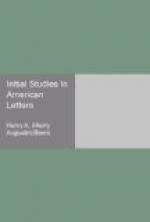After the conclusion of peace with England, in 1783, political discussion centered about the Constitution, which in 1788 took the place of the looser Articles of Confederation adopted in 1778. The Constitution as finally ratified was a compromise between two parties—the Federalists, who wanted a strong central government, and the Anti-Federals (afterward called Republicans, or Democrats), who wished to preserve State sovereignty. The debates on the adoption of the Constitution, both in the General Convention of the States, which met at Philadelphia in 1787, and in the separate State conventions called to ratify its action, form a valuable body of comment and illustration upon the instrument itself. One of the most notable of the speeches in opposition was Patrick Henry’s address before the Virginia Convention. “That this is a consolidated government,” he said, “is demonstrably clear; and the danger of such a government is, to my mind, very striking.” The leader of the Federal party was Alexander Hamilton, the ablest constructive intellect among the statesmen of our Revolutionary era, of whom Talleyrand said that he “had never known his equal,” whom Guizot classed with “the men who have best known the vital principles and fundamental conditions of a government worthy of its name and mission.” Hamilton’s speech On the Expediency of Adopting the Federal Constitution, delivered in the Convention of New York, June 24, 1788, was a masterly statement of the necessity and advantages of the Union. But the most complete exposition of the constitutional philosophy of the Federal party was the series of eighty-five papers entitled the Federalist, printed during the years 1787-88, and mostly in the Independent Journal of New York, over the signature “Publius.” These were the work of Hamilton, of John Jay, afterward, chief-justice, and of James Madison, afterward president of the United States. The Federalist papers, though written in a somewhat ponderous diction, are among the great landmarks of American history, and were in themselves a political education to the generation that read them. Hamilton was a brilliant and versatile figure, a persuasive orator, a forcible writer, and as secretary of the treasury under Washington the foremost of American financiers. He was killed in a duel by Aaron Burr, at Weehawken, in 1804.
The Federalists were victorious, and under the provisions of the new Constitution George Washington was inaugurated first President of the United States, on March 4, 1789. Washington’s writings have been collected by Jared Sparks. They consist of journals, letters, messages, addresses, and public documents, for the most part plain and business-like in manner, and without any literary pretensions. The most elaborate and the best known of them is his Farewell Address, issued on his retirement from the presidency in 1796. In the composition of this he was assisted by Madison, Hamilton, and Jay. It is wise in substance and dignified, though somewhat stilted in expression. The correspondence of John Adams, second President of the United States, and his Diary, kept from 1755-85, should also be mentioned as important sources for a full knowledge of this period.




